
Bro Church is a medieval era Lutheran church at Bro on the Swedish island Gotland. Situated on what was possibly a pre-Christian sacred site, the presently visible church was built during the 13th century. Stylistically, its architecture shows a mix of Romanesque and Gothic elements. It still contains some medieval furnishings, including a baptismal font by Sigraf, and murals. The church belongs to the Väskinde parish in the Diocese of Visby of the Church of Sweden.

Gothem Church is a medieval church in Gothem on the Swedish island of Gotland. Gothic in style, it has remained largely unaltered since the 14th century. It lies in the Diocese of Visby.

Grötlingbo Church is a medieval church in Grötlingbo on the Swedish island Gotland. The stately Gothic church contains elements of a Romanesque frieze, incorporated from an earlier church building on the same site. Görtlingbo Church lies within the Diocese of Visby.
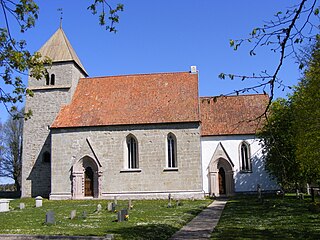
Hablingbo Church is a medieval church in Hablingbo on the Swedish island of Gotland. It is one of the largest churches on Gotland, and dating largely from the 14th century, although the current church building was preceded by a stave church. The stone portals of the church are comparatively richly decorated. It is used by the Church of Sweden and part of the Diocese of Visby.

Martebo Church is a medieval church on the Swedish island of Gotland. Its three portals contain some of the richest medieval sculpture on the island. Martebo Church lies in the Diocese of Visby.
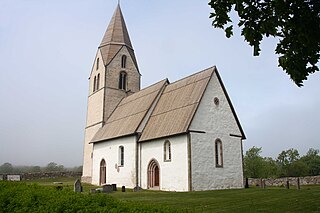
Sundre Church is a medieval church on the Swedish island of Gotland. It was built during the 13th century and has remained largely unaltered since. It lies in the Diocese of Visby.

Tingstäde Church is a medieval church on the Swedish island of Gotland, in the Diocese of Visby. Its present appearance dates largely from the 13th and 14th centuries.

Lau Church is a medieval church on the Swedish island of Gotland, in the Diocese of Visby. It is an unusually large church, and may have been used by Dominicans preaching for the Crusades.
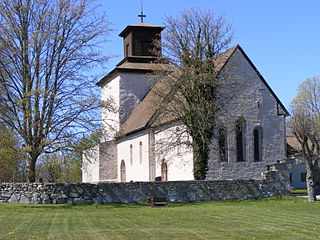
Vamlingbo Church is a medieval church on the Swedish island of Gotland, and one of the largest on the island. It lies in the Diocese of Visby.

Anga Church is a 13th century church in Anga on the Swedish island of Gotland. It is one of the most well-preserved Romanesque churches on Gotland, and was possibly preceded by a stave church. Inside, the church is decorated with medieval murals from three different periods, as well as some medieval furnishings. Some wooden sculptures from the church are today exhibited in a museum in Visby. The church belongs to the Church of Sweden and lies within the Diocese of Visby.

Alva Church is a medieval church in Alva on the Swedish island of Gotland. The oldest parts of the church date from the late 12th century; with the halted construction of the tower about a century later, building activity ceased. The church contains medieval murals as well as a number of medieval furnishings and pieces of art. It lies in the Diocese of Visby of the Church of Sweden.
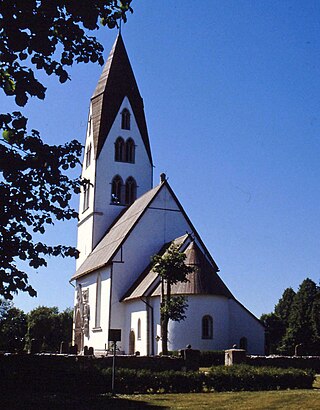
Stånga Church is a medieval church in Stånga on the Swedish island of Gotland. The site of the church has probably been considered sacred since before the Christianization of Scandinavia.

Hemse Church is a medieval Lutheran church in Hemse on the island of Gotland. Preceded by the most well-preserved early stave church discovered in Sweden, the current church dates mainly from the 13th century. It contains sets of medieval murals as well as some medieval furnishings. It is part of the Diocese of Visby.

Eke Church is a medieval church in Eke on the Swedish island of Gotland. The church was built during the 12th and 13th century, with only smaller additions and changes made later. Inside, several medieval murals survive. The church is used by the Church of Sweden and lies in the Diocese of Visby.

Lärbro Church is a medieval church in Lärbro on the Swedish island of Gotland. The church is located at a former strategically important spot, as testified by the adjacent fortified tower. The presently visible Gothic church replaced an earlier Romanesque church during the 13th and 14th century. The cemetery of the church contains several graves of victims from Nazi concentration camps who were taken to a field hospital in Lärbro during and after World War II.
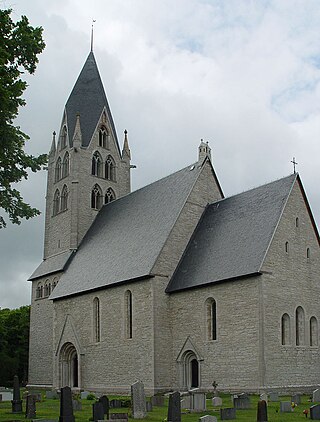
Dalhem Church is a medieval church in Dalhem on the Swedish island of Gotland. Built in the 13th and 14th century, the church underwent major changes during a renovation at the turn of the 19th–20th centuries. Dalhem Church lies in the Diocese of Visby of the Church of Sweden.

Endre Church is a medieval church in Endre on the Swedish island of Gotland, in the Diocese of Visby, built from the 12th to early 14th century. It contains medieval murals and several medieval furnishings, and belongs to the Church of Sweden.

Viklau Church is a medieval church on Gotland, Sweden. It is a well-preserved Romanesque church in which several medieval items have been preserved. The most famous of these is the Viklau Madonna, today housed in the Swedish History Museum in Stockholm.

The Viklau Madonna is a late 12th-century wooden Madonna, probably made on Gotland in present-day Sweden. The statuette is one of the best-preserved 12th-century wooden statuettes from Europe. Named after the medieval Viklau Church where it was originally located, it was bought by the Swedish History Museum in 1928 and is today in the museum in Stockholm. In 2017, it was discovered that a relic had been placed inside the statuette. The statuette depicts Mary, wearing gilded clothes and a golden crown, sitting on a tall chair. Originally, the Madonna was depicted holding the infant Christ in her arms, but this part of the sculpture has been lost.





















